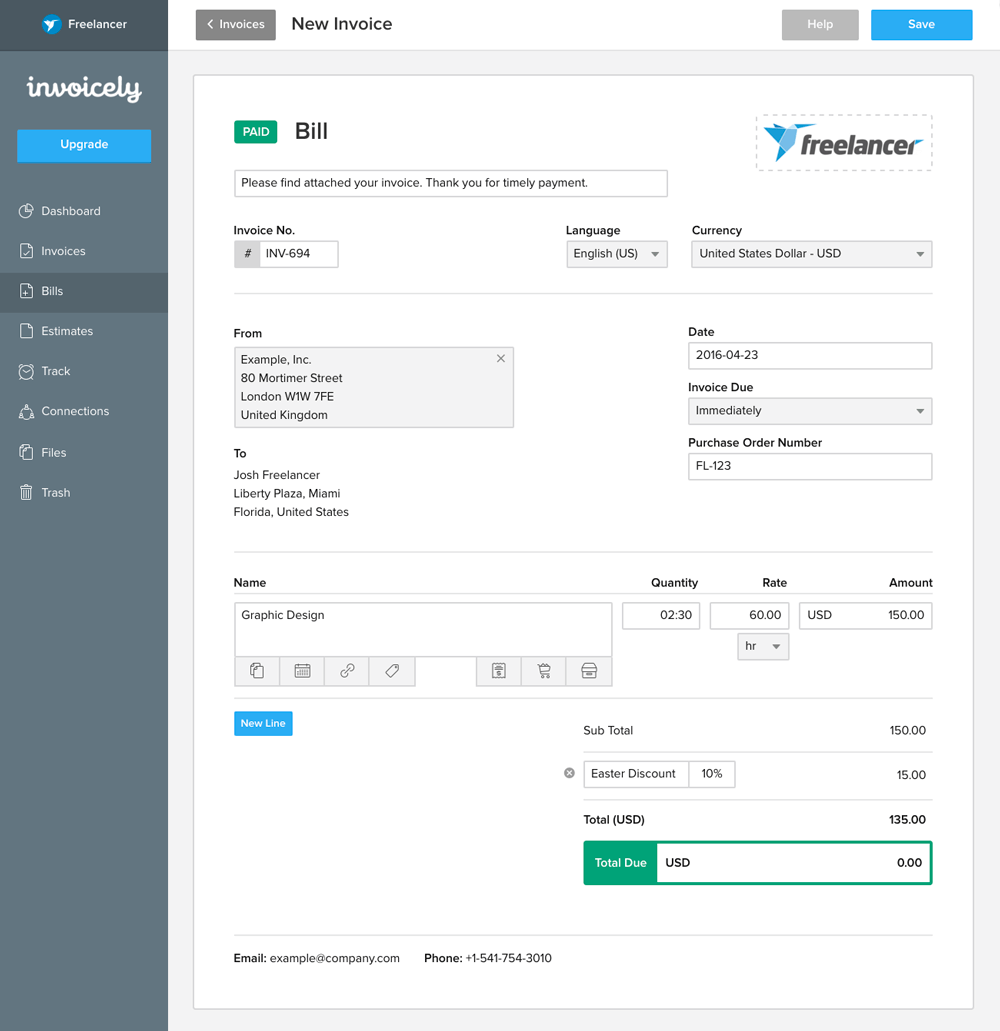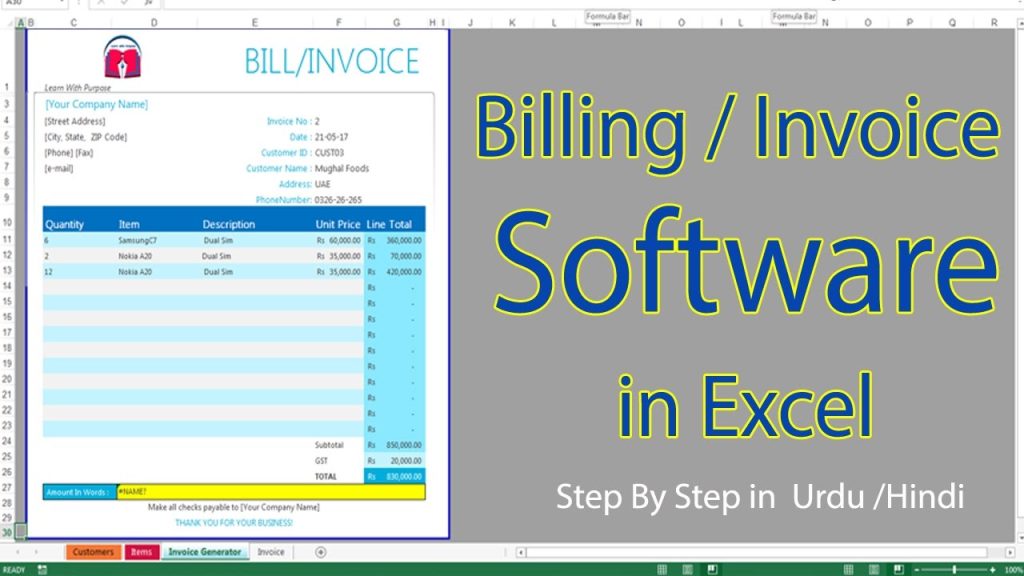Creating invoice software can streamline your business operations. It helps manage finances efficiently.
In this blog post, we will guide you through the process of creating your own invoice software. Businesses, large and small, need a reliable way to handle invoices. Manual invoicing can be time-consuming and prone to errors. Automated invoice software solves these problems by offering accuracy and efficiency.
With your own custom software, you can tailor it to meet your specific needs. It doesn’t require a degree in programming; just follow a few clear steps. This guide will help you understand the basics, from essential features to the technical tools you need. Let’s dive into the world of invoice software creation and make your business operations smoother.

Credit: invoicely.com
Introduction To Invoice Software
Invoicing is a key part of any business. It helps track sales and payments. Without good invoices, a business may face issues. Proper invoices ensure clients pay on time. They also help in keeping records clear.
An invoice lists what was sold. It shows prices and taxes. It also shows payment terms. This helps in avoiding confusion. Clear invoices build trust with clients. In short, invoicing is important for smooth business operations.
Invoice software can save time. It makes creating invoices easy. You can use templates. This ensures all invoices look the same. It also reduces mistakes. Software can do the math for you.
Invoice software can track payments. It sends reminders to clients. This helps in getting paid on time. The software can also store all invoices in one place. This makes it easy to find old invoices. In short, invoice software helps in many ways.

Credit: www.paymoapp.com
Market Research
Market research is key to creating effective invoice software. Understand user needs, analyze competitors, and identify market trends. This helps develop features that solve real problems.
Identifying Target Users
First, know who will use your software. Small businesses, freelancers, and large companies all need invoices. Each group has different needs. Small businesses may need simple tools. Freelancers may want easy templates. Large companies might need integration with other systems. Understand these needs.
Analyzing Competitors
Study the market. See what other software is out there. Look at their features. What do they do well? Where do they fall short? Check user reviews. Learn from them. Find gaps you can fill. Offer something better.
Planning Your Software
Your invoice software needs important features. Basic features include creating invoices, tracking payments, and managing clients. Adding customizable templates can make invoices look professional. Consider including tax calculations to help users. Also, reminders for unpaid invoices can be useful. Reporting features will help users see their finances easily. Secure storage is a must for client data.
Set clear goals for your software. Decide what problems it will solve. Think about who will use the software. Small businesses, freelancers, or large companies might need it. Know your audience. Identify your target market. Set a timeline for development. Break down the project into smaller tasks. This helps in tracking progress. Stay focused on your goals.
Choosing The Right Technology
Pick a programming language that suits your needs. Many use JavaScript for its flexibility. Python is great for its readability. Java offers strong performance for large systems. C# is popular with Windows applications. Each language has its strengths.
Frameworks help speed up development. React is great for building user interfaces. Django is a powerful Python framework. Spring works well with Java. .NET is ideal for C# projects. Tools like Git help with version control. Docker makes deployment easier. Choose tools that fit your stack.
Designing The User Interface
Start with a simple sketch. This shows the app’s layout. Use basic shapes to represent buttons and fields. These sketches help plan the design. They make changes easy. Share these with your team. Get feedback early.
Use online tools for better wireframes. Some tools are free. They can save time. Make sure your design is clear. Avoid too much detail in wireframes. Focus on the main layout.
Think about the user. Make the design easy to navigate. Keep menus and buttons simple. Users should find what they need fast. Test with real users. Watch how they interact. Make changes based on their feedback.
Colors and fonts matter. Use them wisely. Make sure text is easy to read. Avoid bright colors that hurt eyes. Keep the design consistent. Users like familiarity. They feel comfortable with it.
Developing Core Features
Start with a basic design. Keep it clean and simple. Add fields for the company name, client name, and invoice number. Include a section for line items. Each line should have a description, quantity, and price. Make sure to have a total at the bottom. Add a spot for taxes and discounts if needed. Make the template easy to edit. Users should quickly add or remove items. Use a PDF format for the final invoice. This keeps the layout consistent.
Choose a payment gateway. Popular options include PayPal and Stripe. Ensure the gateway supports many payment methods. Set up the API for the gateway. This allows the software to talk to the payment service. Add a payment button to the invoice. Clients can click to pay. Show a confirmation once payment is complete. Make sure the transaction is secure. Use SSL to protect data. Keep a record of all payments. This helps with tracking and reporting.
Testing And Quality Assurance
Creating invoice software involves meticulous testing and quality assurance. These steps ensure the software functions correctly and meets user needs. Regular checks help identify and fix issues early. This results in a more reliable and efficient product.
Automated Testing
Automated tests can save time. They run without human help. These tests find bugs fast. They help keep the code clean. Automated testing can catch errors early. It ensures the software works well. Automated tests can run all day. They do not get tired. Automated tests are reliable. They help improve quality.
User Testing
User testing is key. Real people use the software. They find issues developers miss. Users give feedback. Their input is priceless. It shows how the software works in real life. User tests can find bugs. They help improve the design. User feedback can make the software better. It ensures the software meets user needs.

Credit: www.integratepayments.com
Deployment And Maintenance
Choosing the right hosting option is crucial. Cloud hosting offers flexibility. You can access it from anywhere. It’s also easy to scale. On-premises hosting gives more control. But, it needs more management. Consider your needs. Think about security, cost, and scalability.
Ongoing support keeps your software running smoothly. Regular updates fix bugs and improve features. Customer support helps with issues. Make sure support is available 24/7. This ensures your software is always up and running. Choose a provider with good reviews. They should offer reliable support.
Marketing Your Software
Build a website for your software. Make it clean and simple. Add details about your software. Make sure the site loads fast. Use keywords to help people find you. Share updates on social media. Use platforms like Facebook and Twitter. Join forums where people talk about software. Answer questions and share tips. This builds trust. People will start to see you as an expert.
Ask users for feedback. Listen to what they say. Make improvements based on their suggestions. Happy users will tell others. This helps you get more users. Show testimonials on your website. People trust other users’ opinions. Offer a way for users to rate your software. High ratings attract new users. Respond to feedback quickly. This shows you care about your users. Happy users mean more business.
Future Enhancements
Adding new features is key to keeping users happy. User feedback helps decide which features to build. Regular updates ensure the software stays current. New features can make the software more useful. This can attract more users.
Scaling the software means making it handle more users. Cloud services can help scale easily. Efficient coding also helps with scaling. Planning for growth keeps the software running smoothly. Making it scalable from the start saves time later.
Frequently Asked Questions
What Is Invoice Software?
Invoice software automates the process of creating, sending, and managing invoices. It helps businesses track payments and manage finances efficiently.
Why Create Custom Invoice Software?
Custom invoice software tailors to your specific business needs. It provides features that match your workflow, improving productivity and accuracy.
What Features Should Invoice Software Have?
Essential features include invoice creation, payment tracking, client management, and reporting. Customizable templates and integration with accounting systems are also important.
How To Start Developing Invoice Software?
Begin by defining your requirements. Choose the right technology stack and design user-friendly interfaces. Test thoroughly before deployment.
Conclusion
Creating invoice software can streamline your business operations. It saves time and reduces errors. Following the steps above ensures a smooth process. Always test your software thoroughly. Seek feedback from users. Keep improving based on their suggestions. This approach leads to efficient and user-friendly invoice software.
Happy coding!


